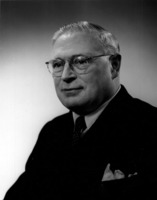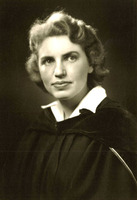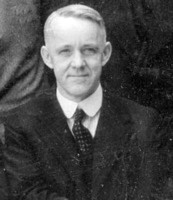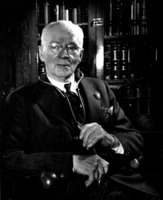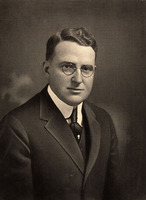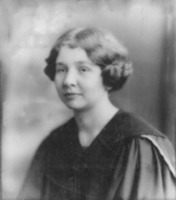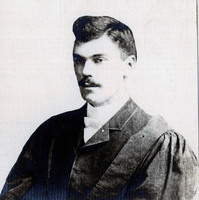Notable People
Although there are many faculty and alumni of Western University's School of Medicine who have provided the school and community with excellent service, this page will outline a few of the more influential individuals who have changed the face of medicine or whose influence at Western was noteworthy.
Dr. J. Bertram Collip
Developed the Refining Process for Insulin
Appointed as a biochemistry lecturer at the University of Alberta's Department of Physiology, Dr. Collip became a full professor in 1920. Taking a sabbatical in 1921 for a position with Professor J. J. R. Macleod at the University of Toronto's Department of Physiology, Dr. Collip was able to further his studies on the effects of pH on the concentration of sugar in the blood. As Macleod was overseeing the work of Frederick Banting and Charles Best for their research in the treatment of diabetes, an opportunity arose for Collip to be a part of this ground breaking discovery. In December of 1921, Banting and Best were having difficulties refining the insulin to a pure enough state to be used in clinical trials. Dr. Collip joined the team and within one month he had achieved the goal of creating a pure enough pancreatic extract. This allowed for Banting and Best to successfully complete the clinical trials allowing insulin to be available for use by diabetes sufferers. Although Dr. Collip has been forgotten for his work in discovering insulin, his efforts have been acknowledged through many awards and honours.
Dr. Carol Whitlow Buck
First Woman to Attain Full Professorship and Department Head
A graduate of Western's medical program in 1947, Carol Whitlow Buck received her Ph.D. in the Department of Clinical Preventative Medicine for her work done under the guidance of Dr. G. E. Hobbs. Upon her graduation, Dr. Whitlow received an appointment at Western as an assistant professor. Further training at the University of London allowed Dr. Whitlow the opportunity to attain full professorship in 1962. Dr. Whitlow held many titles during her career at Western; however, the most ground breaking for women was the position she received in 1967 as Head of the Department of Community Medicine. In 1972, after the division of the Department of Community Medicine, Dr. Whitlow became Chair of the Department of Epidemiology and Preventative Medicine.
Dr. James Wellington Crane
Influential in Student Life and Activities
Although the research aspects of his career were not as notable as his contemporaries within the Faculty, Dr. James Wellington Crane's main contribution came from the influence he had on his students and alumni. Dr. Crane was known by his students for his motto: "Work, observe, think and record." Students were expected to live this motto as questions like, "How many steps are there at the front entrance?," would often appear on his tests.
Known for taking an interest in the personal lives of his students, Dr. Crane was always willing to provide his students with the advice and assistance they needed whether it was finding summer employment, dealing with personal problems, or loaning money.
A founder of the Harvey Club, Osler Society, and the early sing-songs that gave rise to the Meds Merrymakers, Dr. Crane was dedicated to providing a positive and enjoyable experience to those attending the Faculty of Medicine.
Dr. Edwin Seaborn
Commanding Officer, the No. 10 Canadian Stationary Hospital
Made shortly after outbreak of World War I, Western University’s initial offer to establish a hospital unit for overseas service was declined by the government. In March, 1916, Dr. Seaborn, Dr. McCallum and Dr. Beal, on behalf of the Medical Faculty, requested that the University renew its offer. Appointed by the Board of Governors to present the offer, President Braithwaite and Dr. Seaborn met with A.E. Kemp, Acting Minister of Militia, in Ottawa on March 22. The War Office accepted the offer to furnish a 400-bed hospital on April 28, 1916.
The Board of Governors named Dr. Seaborn commanding officer of the No. 10 Canadian Stationary Hospital on May 2, 1916. A committee consisting of Braithwaite, C.R. Somerville, Dr. McCallum and J.W. Little, was appointed by the Board to assist Seaborn in the selection of the medical and nursing staff.
The unit embarked for England in July and August, 1916. While many of the original members were dispersed to other facilities, Seaborn and the remaining personnel assumed the operation of hospitals in Sussex before proceeding to Calais, France in December, 1917. While in operation, the No. 10 hospital treated more than 16,000 patients. Demobilized in April, the unit returned to London in May, 1919.
Dr. Leonard G. Rowntree
Awarded the Medal of Merit in 1946
Leonard G. Rowntree graduated from Western medical school in 1905 as a gold medallist. After an internship at Victoria Hospital, Rowntree held a general practice in Camden, New Jersey until joining John Hopkins Medical School. He became an Associate Professor in 1914 and held appointments in pharmacology, experimental therapeutics, and medicine. Taking an appointment at the University of Minnesota, Rowntree quickly became the Chief of the Department of Medicine in 1916. For his exemplary medical career, The University of Western Ontario awarded him an honorary Doctor of Science degree in 1916.
As World War II broke out, Rowntree joined the US Army Medical Corp and became the Executive Medical Officer of Medical Research and Laboratories of the American Expeditionary Force. Upon returning after the war, Rowntree became Director of the Philadelphia Institute for Medical Research and was soon appointed the Chief of Medical Divisions of the Selective Service by President Roosevelt. In this position, Rowntree applied standards of fitness to the armed forces recruitments. Awarded the Medal of Merit from President Truman in 1946 for his work, Rowntree assisted in the founding of a medical faculty at the University of Miami and became Chief of Medical Consultants at the Veteran's Hospital.
Dr. Dorothy Kathleen Braithwaite(Sanborn)
Western University's First Female Medical Student
Dorothy Kathleen Braithwaite was born in llderton in 1900. Graduating from London Collegiate Institute with a Senior Matriculation Certificate in 1917, Dr. Braithwaite went on to receive a Bachelor of Arts degree from Western University. In March of 1918 the Executive Committee at Western passed a resolution to admit women into the Faculty of Medicine using the same regulations and requirements for men. Dr. Braithwaite entered the program and in 1924 she received her Medical Doctor certification. After a two year internship at City Hospital in Buffalo and Victoria Hospital, Dr. Braithwaite opened a practice in Windsor with her husband Clare S. Sanborn, also a graduate of Western's medical program.
Dr. James A. Gibson
University of Buffalo's Gibson Society Founded in his Honour
Dr. James A. Gibson graduated from Western medical school in 1890. After working at St. Bartholomew's Hospital and the London Hospital, Gibson became Professor of Anatomy at the University of Buffalo. He was twenty-six years old at the time of his appointment. Gibson was known as being an excellent teacher and well-respected by his students.
Upon his death, the medical students of the 1919-1920 class at the University of Buffalo began a society in his honour, known as the James A. Gibson Anatomical Society. The Society was meant to "form a living tribute to the memory of Dr. James A. Gibson" and promote endeavours in anatomical study and research. Their constitution laid out their objectives, memberships and by-laws. An annual meeting was held, and included a dinner with an anatomical lecture by a guest speaker.
